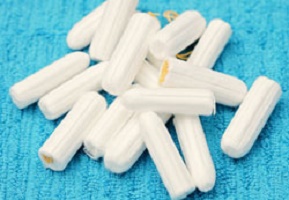The Maxi With The Moxie:
Green Menstrual Products
by Jeanne M. Lambert
 What's commonly used, rarely discussed and has a greater impact on the environment than disposable diapers? What's white (or pastel pink or blue) but not at all green? What is this disposable product that has escaped mainstream criticism even though alternatives exist? The answer: women's sanitary products. What's commonly used, rarely discussed and has a greater impact on the environment than disposable diapers? What's white (or pastel pink or blue) but not at all green? What is this disposable product that has escaped mainstream criticism even though alternatives exist? The answer: women's sanitary products.
On average, women spend two to three times more days using menstrual products in a lifetime than they or their children spend in diapers. Many of these products end up in sewage systems. Many tampon applicators litter beaches. The pads end up in landfill sites. These are fairly serious considerations and affect all of human, plant, and animal life. This information alone may provide motivation for change if one is concerned about such things.
What of the personal health questions? With deodorized, scented, chlorine-bleached tampons, mini-pads, maxi-pads, regular, thin, super...among the many commercial options, many women have assumed that there are safety standards for products such as these.
But truthfully, there are no enforced requirements, no minimal standards for safety. With toxic-shock syndrome still a concern and the carcinogenic dioxins potentially in any bleached products, this deserves more serious research and might give the needed motivation to change current habits.
What are the alternative options? Our grandmothers used rags and strips of cloth and would leave them behind when traveling, or soak, wash and reuse them when at home. It may seem like a step backward for women to take this approach. Who needs more laundry? More work for women?
There are several greener options available but first and foremost, a change in mindset is required – not only to include sanitary products in our greening efforts but to change our attitudes toward our menses.
In many simpler cultures, women seclude themselves during their menstruation. Rather than seeing this as a quarantine imposed by men, as it was once negatively described, it would be a break from the daily routine and chores, an opportunity to be with and learn from other women. It would be nice if we could have that little R & R and experience of community every few weeks in this day and age!
To make the switch from disposables to reusable products requires an attitude change from being able to 'throw away the “mess” (or is it the evidence?) of our menses and perfume and deodorize at the same time, to accepting the reality of this natural part of our bodies. The menstrual cycle is a big part of being feminine – of being a woman. It is a time to be celebrated.
The Options
For those not comfortable wearing pads, there is a soft, natural rubber menstrual cup that is worn internally that catches and holds menstrual blood. It is easily removed, long-lasting and reinserted, and has no health risk. Not only does it have a positive impact on the environment, but it will save hundreds of dollars in other commercial sanitary products.
Some women use natural sponges; a more simple, yet effective, absorbent material. However, the jury is still out on the safety of this approach, considering most of these sponges grow in polluted ocean waters and essentially no testing has been done.
Many women prefer pads and for them there are many options. There are different cottage industries marketing cotton sanitary pads in every shape, size, color and thickness possible. These flannel pads are made of 100 percent cotton – in some cases organic and or unbleached. Most of them have a covering with wings to snap around the panty or a G-string arrangement and have a folding removable liner that allows for thorough cleaning and quick drying.
There are smaller width pads available for young women. Different absorbencies of pads allow for individualizing the set of pads to suit your need. One product is available in three different colour schemes – gentle pastel prints, vibrant dark prints, or unbleached organic cotton. Some women use the cup during their heavy flow and cotton pads at other times.
The Work
What of the work involved? The key to keeping the pads from staining is soaking them. This makes washing easy. There is no rush to get them into the washer. The time is limited only by the number of pads you own. An automatic washer does a great job getting them clean and they hang dry overnight, although an automatic dryer will fluff the cotton fibers more. The menstrual cup needs only to be rinsed out.
When at work, women find the menstrual cup easy to use and travel bags are available to store pads safely when en route.
Says one user, “Contrary to feeling burdened or put-off by washing my pads, I feel pampered. The cotton is so nice. The same reasons I cloth-diapered my babies all apply!”
Say others: “The cotton is so soft, I feel clean and comfortable throughout my cycle.” and “I feel ecologically virtuous.”
Many women are finding comfortable and effective alternatives to conventional sanitary products. Perhaps the adage “try it, you'll like it” applies. In addition to feeling more connected with the web of all natural life, you may benefit from better health and save money, too!
Jeanne M. Lambert is a freelance writer who lives with her family in an owner-built solar home in Ontario, Canada.
This article was published in Natural Life Magazine in 1995.
|

